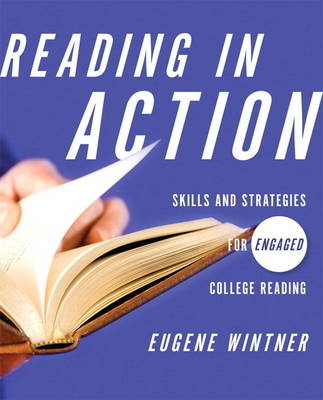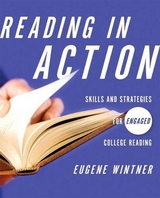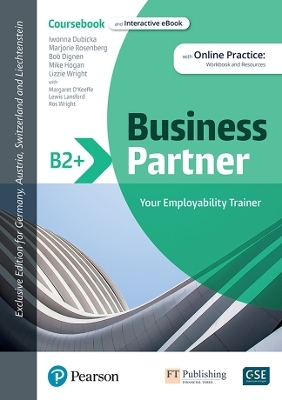
Reading in Action (with MyReadingLab Student Access Code Card)
Longman Inc
978-0-205-02612-8 (ISBN)
- Titel erscheint in neuer Auflage
- Artikel merken
Preface xiii
Introduction: You, the Reader 1
The Importance of Reading Skills in the Information Age 1
Goal Setting 2
Becoming an Active and Engaged Reader 4
Discovering Your Learning Style and Reading Style 6
Writing Your Reading Autobiography 11
You, the Reader: Introduction Wrap-up 11
1 Using Pre-Reading Strategies 13
Preparing to Read: Reinforcing Concentration 15
Active Reading Strategy: Previewing 16
Active Reading Strategy: Relating to the Subject 26
Active Reading Strategy: Forming Goal Questions 32
Skills Online: Previewing Web Sites 38
Reading 1A Psychology of Self-Awareness (Psychology) 40
Reading 1B Understanding Consumer Behavior (Business) 46
Chapter 1 Review 53
Chapter Tests 54
Test 1.1. Previewing 54
Test 1.2. Relating to the Subject 54
Test 1.3. Previewing and Relating 54
Test 1.4. Goal Questions from Headings 57
You, the Reader: Chapter 1 Wrap-up 57
2 Context and Dictionary 58
Context 59
Multiple Meanings 61
Active Reading Strategy: Using Context Clues 63
Definition Clues and Synonyms 65
Contrast Clues 67
Indirect Context Clues 70
Context Clues in Short Passages 71
Active Reading Strategy: Matching Dictionary Definitions with Context 77
Parts of Speech 80
Usage Labels and Subject Labels 84
Using the Dictionary Pronunciation Key 89
Skills Online: Using an Online Dictionary 91
Reading 2A Success Is a Choice (Self-Help) 93
Reading 2B Adapting to Today's Job Market (Business Communications) 98
Chapter 2 Review 105
Chapter Tests 106
Test 2.1. Using Context Clues (Sentences) 106
Test 2.2. Using Context Clues (Passage) 107
Test 2.3. Context and Dictionary (Sentences) 108
Test 2.4. Context and Dictionary (Passage) 108
You, the Reader: Chapter 2 Wrap-up 110
3 Understanding Word Structure 111
Introduction to Word Structure 112
Prefixes 113
Negative Prefixes 114
Number Prefixes 115
Other Common Prefixes 117
Learning the Prefixes 118
Suffixes 120
Spelling Changes with Suffixes 121
Etymology 125
Skills Online: Learning More Prefixes and Suffixes 127
Reading 3A The Myth and Reality of Multitasking (General Interest) 128
Reading 3B Friendship (Interpersonal Communication) 134
Chapter 3 Review 142
Chapter Tests 143
Test 3.1. Prefixes 143
Test 3.2. Prefixes 143
Test 3.3. Suffixes 144
Test 3.4. Etymology 144
You, the Reader: Chapter 3 Wrap-up 145
4 Paragraph Logic: Topic and Main Idea 146
General vs. Specific 147
Active Reading Strategy: Identify the Paragraph's Topic 151
Active Reading Strategy: Identify Stated Main Ideas 157
What Is a Main Idea? 157
General vs. Specific Sentences 160
Stated Main Ideas 164
Locating Stated Main Ideas 166
Skills Online: Finding Stated Main Ideas 179
Reading 4A The Eyewitness on Trial (Psychology) 179
Reading 4B Significance of Movies
(Communication/Media) 187
Chapter 4 Review 196
Chapter Test 197
Test 4.1. Paragraph Logic 197
Test 4.2. Paragraph Logic 199
You, the Reader: Chapter 4 Wrap-up 202
5 Paragraph Logic: Main Ideas and Supporting Details 203
Purposes of Supporting Details 204
Examples 205
Evidence 205
Reasons 206
Active Reading Strategy: Outlining and Diagramming Paragraphs 214
How to Outline a Paragraph 214
How to Diagram a Paragraph 219
Active Reading Strategy: Recognizing Implied Main Ideas 225
Main Ideas and Supporting Details in Short Passages 232
Skills Online: Working with Paragraphs 237
Reading 5A 2008: An Election about Change (Government) 237
Reading 5B New Ways to Stop Crime (Criminal Justice) 246
Chapter 5 Review 254
Chapter Tests 255
Test 5.1. Supporting Details 255
Test 5.2. Outlining and Diagramming Paragraphs 256
Test 5.3. Implied Main Ideas 256
Test 5.4. Main Ideas in Short Passages 258
You, the Reader: Chapter 5 Wrap-up 260
6 Monitoring and Clarifying Comprehension 261
Making Sense 262
Active Reading Strategy: Monitoring Comprehension 266
Anticipating the Text 269
Using Active Reading Strategies to Clarify and Strengthen Comprehension 270
Active Reading Strategy: Paraphrasing 277
When the Going Gets Tough 282
Skills Online: Monitoring Your Comprehension Online 286
Reading 6A Waking Up to Our Dreams (Psychology) 286
Reading 6B Nutrition: Eating for Optimum Health (Health) 293
Chapter 6 Review 304
Chapter Tests 305
Test 6.1. Monitoring Comprehension 305
Test 6.2. Paragraph Sense 305
Test 6.3. Clarifying Comprehension 306
Test 6.4. Paraphrasing 306
Test 6.5. Clarifying Comprehension 307
You, the Reader: Chapter 6 Wrap-up 309
7 Connecting Ideas: Sentence Relationships and
Transition Words 310
Active Reading Strategy: Identifying Sentence Relationships 311
Sequence 312
Addition 313
Contrast 313
Reason 314
Active Reading Strategy: Recognizing Transition Words 319
Transition Words That Indicate Sequence 319
Transition Words That Indicate Addition 320
Transition Words That Indicate Contrast 321
Transition Words That Indicate Reason 322
Skills Online: Recognizing Transition Words and Sentence Relationships 334
Reading 7A Can Animals Talk? (Nature) 334
Reading 7B Darwin and the Theory of Evolution (Biology) 341
Chapter 7 Review 348
Chapter Tests 349
Test 7.1. Sentence Relationships 349
Test 7.2. Transition Words 349
Test 7.3. Transition Words and Sentence Relationships 350
Test 7.4. Transition Words and Sentence Relationships in a
Short Passage 351
You, the Reader: Chapter 7 Wrap-up 353
8 Logical Patterns 354
Chronological Order 356
Diagramming Chronological Order 358
Listing 359
Diagramming the Listing Pattern 363
Compare-Contrast 364
Diagramming Compare-Contrast 366
Cause-Effect 367
Diagramming Cause-Effect 372
Definition 373
Diagramming the Definition Pattern 375
Active Reading Strategy: Recognizing Logical Patterns 376
Skills Online: Using Graphic Organizers 391
Reading 8A Sojourner Truth (American History) 392
Reading 8B Stress and the Mind (Psychology) 400
Chapter 8 Review 407
Chapter Tests 408
Test 8.1. Logical Patterns in Paragraphs 408
Test 8.2. Logical Patterns in Short Passages 409
You, the Reader: Chapter 8 Wrap-up 412
9 Inference 414
Making Inferences 415
Literal vs. Inferential Comprehension 417
Inference and Humor 418
Making Logical Inferences 419
Active Reading Strategy: Inferring the Author's Purpose 433
Infer the Author's Purpose from the Context and the Content 434
Authors' Three Main Purposes 434
Active Reading Strategy: Inferring the Author's Tone 437
Skills Online: Identifying the Author's Purpose 450
Reading 9A I Am Crow Dog (American History) 451
Reading 9B Listening (Interpersonal Communication) 457
Chapter 9 Review 465
Chapter Tests 466
Test 9.1. Inference 466
Test 9.2. Purpose and Tone 466
Test 9.3. Inference 467
You, the Reader: Chapter 9 Wrap-up 469
10 Critical Reading 470
Active Reading Strategy: Distinguishing Fact from Opinion 472
Facts 472
Opinions 473
Active Reading Strategy: Evaluating Sources of Information 480
Active Reading Strategy: Evaluating Arguments 484
Skills Online: Critical Reading 502
Reading 10A Violent Video Games Puts Teens at Risk (Sociology) 503
Reading 10B Global Warming: Coming to Your Backyard (Environmental
Science) 511
Chapter 10 Review 520
Chapter Tests 521
Test 10.1. Fact vs. Opinion 521
Test 10.2. Fact and Opinion in Paragraphs 521
Test 10.3. Evaluating Arguments 523
Test 10.4. Critical Reading 524
You, the Reader: Chapter 10 Wrap-up 526
Additional Readings 527
Reading 11 Viva! Barrios Unidos (Human Interest) 528
Reading 12 Who Are the Police? (Criminal Justice) 534
Reading 13 Television in Transition
(Communication/Media) 539
Reading 14 Minds of Their Own: Animals Are Smarter
Than You Think (Nature) 545
Reading 15 The Marshmallow Test (Psychology) 552
Appendix: Understanding Word Structure: Common Roots 559
Credits 567
Index 571
| Erscheint lt. Verlag | 28.11.2011 |
|---|---|
| Verlagsort | New Jersey |
| Sprache | englisch |
| Themenwelt | Schulbuch / Wörterbuch ► Wörterbuch / Fremdsprachen |
| Geisteswissenschaften ► Sprach- / Literaturwissenschaft ► Sprachwissenschaft | |
| ISBN-10 | 0-205-02612-5 / 0205026125 |
| ISBN-13 | 978-0-205-02612-8 / 9780205026128 |
| Zustand | Neuware |
| Haben Sie eine Frage zum Produkt? |
aus dem Bereich



